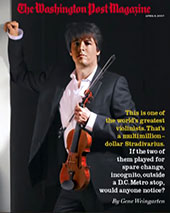In a Washington, DC Metro Station, Joshua Bell, one of the world’s greatest violinists, played a beautiful, intricate, moving piece on a violin worth over 3 million dollars. During the 43 minutes he played, 1,097 people walk by. Only seven stopped to listen, and even those seven paused for only a few minutes. Two days before, Joshua Bell had played the same music to a sold-out audience in Boston where the seats averaged $100 each. His minimum fee for playing a public concert was $75,000. How could so many people have walked by?
That so few people stopped was not a demonstration of the cluelessness of these commuters, but how the busyness of our daily life can sometimes prevent us from noticing the beautiful and miraculous world all around us. How many amazingly beautiful things do we miss in a day, simply because of the pace of our lives and the intense focus on getting to the next thing?
Videos
This week's videos include The Monkey Business Illusion by Daniel Simons, a cognitive scientist at University of Illinois, who illustrates both the incredible power of attention and the limitations inherent in our ability to perceive fully what is going on around us. Shauna Shapiro gives a compelling account of how meditation creates physical changes in the brain in Mindful Meditation and the Brain, and in Measuring Mindfulness, Judson Brewer correlates brain scan data with subjective experience during meditation. Finally, there are two short pieces by Jon Kabat-Zinn, Life is RIght Now and Coming to Our Senses, followed by an entertaining All it takes is 10 Mindful Minutes that includes juggling and a provocative challenge to do "nothing" for 10 minutes.
Readings
Sitting Meditation describes the practice we are introducing this week. Joshua Bell Plays a $3,000,000 Violin (and almost nobody notices) is a more detailed account of the "concert" described above. The next two readings, How the Brain Rewires Itself and How Meditation Affects the Gray Matter of the Brain discuss the growing body of research that demonstrates how meditative practice, even when done for a relatively short period of time (weeks not years), can physically alter the brain in positive and adaptive ways.
Daily Practices
This week, for the formal practice, we introduce the Sitting Meditation, using breath as the primary object of awareness, alternating this with the Body Scan (Sitting one day, Body Scan the next, etc.). It can seem that the goal of the Body Scan or a Sitting Meditation is to stay focused on exactly one thing at a time (ankle, wrist, breath) and that when you notice your awareness has moved (to a memory, internal narrative, sound and wonderings about the sound), that you are somehow failing. These practices will increase your ability to focus and concentrate, but they will also expand your ability to be with whatever comes into your field of experience, non-judgmentally. Your NOTICING that your attention has moved to another object is, in itself, mindfulness in action. Mindfulness includes both a concentrative attention (think laser beam) AND a capacity to perceive a larger picture (think floodlight). Both are important. Focusing on only one thing leaves the larger picture unseen, and maintaining only a broad focus does not allow exploration of the parts.
The informal practice this week is about becoming aware of how we experience and process pleasant events. They don't need to be major events, they can be something as simple as noticing the sun on your face or someone smiling at you. Just as we did last week, allow a few minutes before going to sleep to complete the informal practice log. Below are your materials for this week:
Videos [with most browsers, once you start the first video, the others will follow automatically]
The Monkey Business Illusion - Daniel Simons [2 min]
Mindful Meditation and the Brain
- Shauna Shapiro [6 min]
Measuring Mindfulness
- Judson Brewer [7 min]
Life is Right Now and Coming to Our Senses - Jon Kabat-Zinn [16 min total]
All it takes is 10 Mindful Minutes - Andy Puddicombe [10 min]
Reading [print these for your manual or read them online]
Sitting Meditation - Jon Kabat-Zinn [excerpted from Full Catastrophe Living]
Joshua Bell plays a $3,000,000 violin (and almost nobody notices)
How the Brain Rewires Itself - Sharon Begley
How Meditation Affects the Gray Matter of the Brain - David R. Hamilton, Ph.D.
Practice sheets [print PDF file or download WORD file to record your daily practices ]
Formal Practice [PDF] [or WORD format] - Body Scan, Sitting Meditation
Informal Practice [PDF] [or WORD format] - Pleasant Events Calendar
Supplementary materials related to this week's topic [optional materials]
Altered Traits
book by Daniel Goldman and Richard Davidson
Why a Neuroscientist Would Study Meditation video by Willoughby Britton [10 min]
Neuroscientist Richard Davidson's Wake-Up Call article/video by Huffington Post [5 min]
How Meditation Can Reshape Our Brains video by Sara Lazar [8 min]
Mastering Your Own Mind article by Katherine Ellison
Positive Emotions and Mindfulness video by Rachel Green [10 min]



